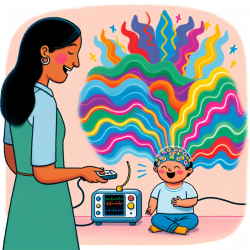Introduction
As speech-language pathologists, understanding the neural mechanisms underlying speech perception in children is crucial for designing effective therapeutic interventions. Recent research by Ríos-López et al. (2020) sheds light on the development of neural oscillatory activity in response to speech in children aged 4 to 6 years. This study provides valuable insights into how young children's brains process speech, which can inform our therapeutic practices.
Understanding Neural Oscillatory Activity
Neural oscillations are rhythmic patterns of neural activity in the brain. They play a critical role in processing auditory information, including speech. The study by Ríos-López et al. focused on speech-brain entrainment, which refers to the synchronization of neural oscillations with the rhythmic patterns of speech. Specifically, they examined delta frequency oscillations (around 0.5 Hz), which are associated with processing the slow temporal components of speech, such as syllabic and prosodic information.
Key Findings
The study found that speech-brain entrainment occurs at delta frequencies in children as young as four years old. This entrainment was observed to be bilateral, involving both hemispheres of the brain, and increased in coherence over time. These findings challenge the previous hypothesis that the right hemisphere is innately specialized for processing prosodic information. Instead, it suggests a more bilateral involvement in processing the slow components of speech in young children.
Implications for Practice
These findings have significant implications for speech-language pathology practice:
- Early Intervention: Understanding that neural entrainment to speech occurs as early as four years old highlights the importance of early intervention. Speech-language pathologists can leverage this period of neural plasticity to introduce interventions that enhance speech perception and language development.
- Customized Therapy: The bilateral nature of delta frequency processing suggests that therapies should not solely focus on right-hemisphere activities. Instead, a more holistic approach that engages both hemispheres may be more effective in supporting speech and language development.
- Monitoring Progress: The study’s longitudinal design underscores the importance of monitoring changes in neural activity over time. Speech-language pathologists can incorporate EEG or other neuroimaging techniques to assess the effectiveness of interventions and adjust them as needed.
Encouraging Further Research
While this study provides a foundational understanding of neural oscillatory activity in young children, further research is needed to explore how these findings can be directly applied to therapeutic practices. Practitioners are encouraged to engage in research collaborations and contribute to the growing body of knowledge in this area. Additionally, exploring the relationship between neural entrainment and specific speech and language outcomes could lead to more targeted interventions.
Conclusion
The study by Ríos-López et al. offers valuable insights into the neural mechanisms of speech perception in young children. By understanding these processes, speech-language pathologists can develop more effective, data-driven interventions that support children's language development. As we continue to learn more about the brain's role in speech processing, our therapeutic practices can become increasingly refined and impactful.
To read the original research paper, please follow this link: Development of neural oscillatory activity in response to speech in children from 4 to 6 years old.










